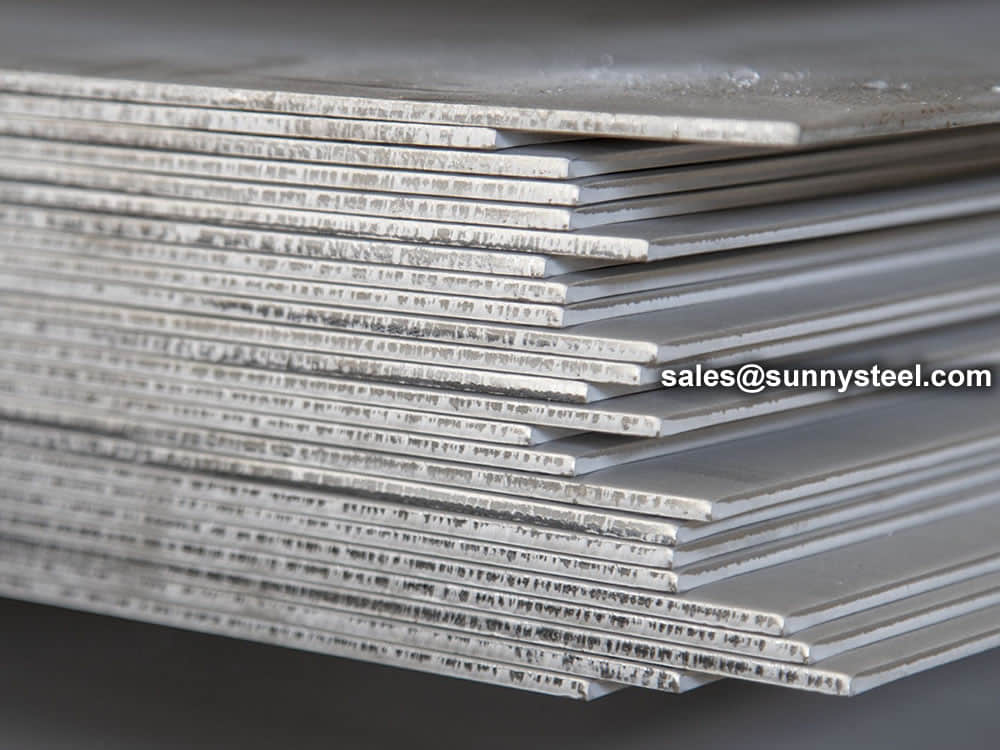
347 stainless steel plate is a type of stabilized austenitic stainless steel that contains columbium and tantalum.
347 stainless steel is variant of the basic austenitic 18/8 Grade 304 with added Columbium – the introduction of Columbium stabilizes the steel and eliminates carbide precipitation which subsequently causes intergranular corrosion.
The steel has excellent forming and welding qualities and excellent toughness even at cryogenic temperatures.
347 and 347H stainless steel plate is a general purpose austenitic stainless steel with a face centered cubic structure. It is non-magnetic in the annealed condition and can only be hardened by cold working. Niobium has been added to suppress grain boundary chromium carbide precipitation. 347H is the higher carbon version of 347 plate. Due to the additional carbon present in 347H plate, it is tougher and generally more durable than 347 plate.
Both 347/347H are used primarily in elevated temperature applications.
Weight % (all values are maximum unless a range is otherwise indicated)
| Chromium | 17.00 min.-19.00 max. | 17.00 min.-19.00 max. |
|---|---|---|
| Nickel | 9.00 min.-13.00 max. | 9.00 min.-13.00 max. |
| Carbon | 0.08 | 0.04 min.-0.10 max. |
| Manganese | 2 | 2 |
| Phosphorus | 0.045 | 0.045 |
| Sulfur | 0.03 | 0.03 |
| Silicon | 0.75 | 0.75 |
| Columbium & Tantalum | 10 x (C + N) min.-1.00 max. | 8 x (C + N) min.-1.00 max. |
| Iron | Balance | Balance |
| DESCRIPTION | Data |
|---|---|
| Proof Stress 0.2% (MPa) | 205 |
| Tensile strength (MPa) | 515 |
| Elongation A5 (%) | 40 |
| Hardness | HB: 201 HRB: 92 |
Alloy 347 (UNS S34700) is columbium stabilized austenitic stainless steel plate with good general corrosion resistance and somewhat better resistance in strong oxidizing conditions than 321 (UNS S32100). It has excellent resistance to intergranular corrosion after exposure to temperatures in the chromium carbide precipitation range of 800 – 1500°F (427 – 816°C). The alloy has good oxidation resistance and creep strength to 1500°F (816°C). It also possesses good low temperature toughness.
Alloy 347H (UNS S3409) stainless steel plate is the higher carbon (0.04 – 0.10) version of the alloy. It was developed for enhanced creep resistance and for higher strength at temperatures above 1000°F (537°C). In most instances, the carbon content of the plate enables dual certification.
Alloy 347 stainless steel plate cannot be hardened by heat treatment, only by cold working. It can be easily welded and processed by standard shop fabrication practices.
Alloy 347 stainless steel plate exhibits good general corrosion resistance that is comparable to 304. It was developed for use in the chromium carbide precipitation range of 800 – 1500°F (427 – 816°C) where un-stabilized alloys such as 304 are subject to intergranular attack. In this temperature range, the overall corrosion resistance of Alloy 347 stainless steel plate is superior to Alloy 321 stainless steel plate. Alloy 347 also performs somewhat better than Alloy 321 in strongly oxidizing environments up to 1500°F (816°C).
The alloy can be used in nitric solutions, most diluted organic acids at moderate temperatures and in pure phosphoric acid at lower temperatures and up to 10% diluted solutions at elevated temperatures. Alloy 347 stainless steel plate resists polythionic acid stress corrosion cracking in hydrocarbon service. It can also be utilized in chloride or fluoride free caustic solutions at moderate temperatures.
Alloy 347 stainless steel plate does not perform well in chloride solutions, even in small concentrations, or in sulfuric acid.
Alloy 347 stainless steel plate can be easily welded and processed by standard shop fabrication practices.
Cold Forming
The alloy is quite ductile and forms easily.
Hot Forming
The high sulfur content of Alloy 303 also has a detrimental impact on hot workability. If hot forming is required, once again, 304 should be considered as an alternate selection.
Machining
The cold work hardening rate of 347 stainless steel plate makes it less machinable than 410 stainless steel, but similar to 304. The table below provides relevant machining data.

When you partner with Sunny Steel, you can stop worrying about meeting deadlines thanks to our responsive and timely service. You'll also say goodbye to unnecessary shopping around. Instead, you'll get white glove service from an expert who understands your needs and can get you the materials you need quickly.
